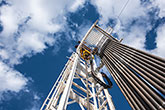Building and operating upstream oil and gas facilities
The costs of building and operating upstream oil and gas facilities saw limited movement during the recent Q1 - Q3, 2013 period, according to two cost indices developed by analyst firm IHS. The marginal cost movement demonstrates the uncertainty that operators are feeling as they face a still-recovering global economy and softening oil prices, IHS says.
Cost of new oil and gas facilities decrease marginally
The IHS CERA Upstream Capital Costs Index (UCCI), which tracks costs associated with the construction of new oil and gas facilities, fell less than 1% from the end of Q1, 2013 to the end of Q3, 2013. Its index score is now 229. The decrease was driven by market fundamentals, particularly declining steel prices and a soft market for rigs.
Operating costs sees small increase
The UCCI’s counterpart, the IHS CERA Upstream Operating Costs Index (UOCI), which measures the operating costs for facilities, rose about 1% over the same period to register an index score of 196. This increase was primarily driven by labour costs, which continue to rise across all skill levels. This upwards pressure on the UOCI was tempered by strong cost decreases in prices for more commoditised products such as proppant and tubing.
Qualified technical professionals hard to find
The IHS indices are proprietary measures of cost changes similar in concept to the Consumer Price Index (CPI) and draw upon proprietary IHS tools to provide a benchmark for comparing costs around the world. Values are indexed to the year 2000, meaning that capital costs of US$ 1 billion in 2000 would now be US$ 2.29 billion. Likewise, the annual operating costs of a field would now be up from US$ 100 million in 2000 to US$ 196 million.
“The individual markets that comprise the indexes will likely finish the year with varying levels of strength,” said David Vaucher, a director at IHS and head of operational costs research. “While it is now much easier than it was a few years ago to procure pumping equipment and proppant, it is still harder than ever to find qualified, technical professionals who can hit the ground running on projects.”
Steel
Steel costs – which have been in decline for more than two years – fell an additional 4.2% during the six-month period. Steel costs are currently at levels comparable to the first quarter of 2010. Asia registered the steepest steel costs decline as a region at 2% as price competition between producers stemming from oversupply in the market continued to drive down prices. Many producers are reporting that prices are now at or near their cost of production.
Upstream engineering and project management costs decreased by 3.5% over the six-month period. However, in local currency terms those costs increased by 2.5% due to a strengthening US dollar, which rose against foreign currencies in most of the regions that are relevant to this category. The largest regional index decrease in dollar terms was 6.8% in Asia, as the Indian rupee depreciated by over 17% and the Australian dollar declined by 14% relative to the US dollar.
Subsea
Subsea costs increased by 1% during the six-month period. Trees and control systems were flat, manifolds and risers increased by 2%, umbilicals rose by 1% and flowlines went up by 3%. The Brazilian pre-salt basins continue to be the region of most activity.
“This levelling off in cost escalation is the calm before the storm,” said Pritesh Patel, a senior director at IHS and head of upstream costs research. “While line pipe and tubular goods costs have fallen and equipment costs have shown little movement in the past six months, these trends are likely to change in 2014 and we could potentially see large increases by the end of next year.”
Momentum to pick up
Despite lingering uncertainty over the global economy and declining oil prices, the latter are still at a level that justifies initial and continued investments, the report concludes. IHS expects a slow period in Q4, 2013 as companies wrap up year-end projects, but momentum should then pick up as they move into new budgeting and spending cycles.
Adapted from press release by Cecilia Rehn
Read the article online at: https://www.oilfieldtechnology.com/drilling-and-production/11122013/the_cost_of_building_and_operating_upstream_oil_and_gas_facilities/
You might also like
tengizchevroil starts WPMP operations at tengiz oil field in Kazakhstan
Chevron has announced today that its 50 % owned affiliate Tengizchevroil LLP (TCO) has safely commenced operations at its wellhead pressure management project (WPMP) at the Tengiz oil field in Kazakhstan.


